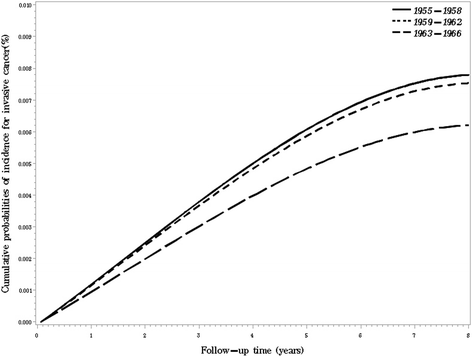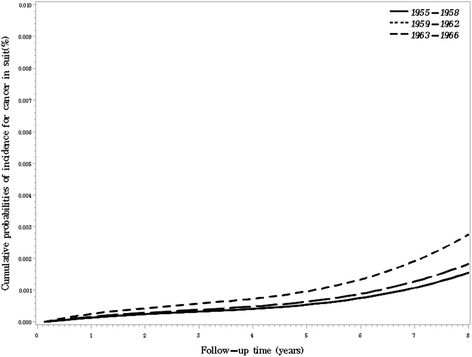Incidence of breast cancer in Chinese women exposed to the 1959-1961 great Chinese famine
- PMID: 29207944
- PMCID: PMC5718143
- DOI: 10.1186/s12885-017-3794-3
Incidence of breast cancer in Chinese women exposed to the 1959-1961 great Chinese famine
Abstract
Background: The association of malnutrition in early life with breast cancer risk has been studied in Europe by investigating survivors of the Dutch Hunger Winter Famine, but not in China. We evaluated the effect of exposure to the 1959-1961 Great Leap Forward famine on subsequent breast cancer risk in Chinese women.
Methods: A total of 59,060 women born in 1955~1966 were recruited from Minhang district, Shanghai, China, during the period 2008 to 2012. A baseline survey was conducted to collect demographic characteristics and known risk factors for breast cancer. Incident breast cancers were identified by conducting record linkage with the Shanghai Cancer Registry up to June 30, 2015, and confirmed through medical records. Cumulative probabilities of cancer incidence were evaluated after adjusting for age, educational level and other confounders. Cox regression models were applied to estimate the hazard ratios (HR) and 95% confidence intervals (CI) of breast cancer.
Results: The overall crude incidence of in situ and invasive breast cancer were 19.2 and 115.0 per 100,000, respectively, in women conceived or born during the famine (1959-1962), slightly higher than those in women born before (1955-1958) (13.2 and 109.8/100,000) and after (1963-1966) (10.4 and 101.5/100,000). Particularly, at age group of 50-52 years when all participants contributed person-year of observations, the age-specific incidence of invasive breast cancer was higher in pre-natal exposed women (123.7/100,000, 95%CI: 94.5-161.9/100,000) than in post-natal exposed (109.6/100,000, 95%CI: 69.1-174.0/100,000) and unexposed women (82.7/100,000, 95%CI: 46.9-145.7/100,000). However, the incidence of cancer in situ was slightly lower in pre-natal exposed women at the age group. Adjusted cumulative probabilities of breast cancer incidence, both in-situ and invasive, were also observed to be higher in women exposed to the famine, however, the difference was not statistically significant.
Conclusion: Our results suggest a possible adverse, but limited, impact of exposure to the Great famine on the risk of breast cancer in Chinese women.
Keywords: Breast cancer; Chinese women; Incidence; The great leap forward famine.
Conflict of interest statement
Ethics approval and consent to participate
All procedures involving human participants were in accordance with the Ethical standards of and approved by the Institutional Review Board (IRB) of the Center for Disease Prevention and Control of Minhang district, Shanghai, China. Due to written consent for any subsequent health surveys and health services has been obtained from all participants when they were registered in the electronic health record system of Minhang district, verbal consent was obtained from each participant for this specific study. The Ethics committee/IRB also approved obtaining verbal consent.
Consent for publication
Not applicable.
Competing interests
The authors declare that they have no competing interest.
Publisher’s Note
Springer Nature remains neutral with regard to jurisdictional claims in published maps and institutional affiliations.
Figures


Similar articles
-
Breast cancer risk after caloric restriction during the 1944-1945 Dutch famine.J Natl Cancer Inst. 2004 Apr 7;96(7):539-46. doi: 10.1093/jnci/djh087. J Natl Cancer Inst. 2004. PMID: 15069116
-
The Association Between Periodontal Disease and Breast Cancer in a Prospective Cohort Study.Cancer Prev Res (Phila). 2020 Dec;13(12):1007-1016. doi: 10.1158/1940-6207.CAPR-20-0018. Epub 2020 Jul 29. Cancer Prev Res (Phila). 2020. PMID: 32727823 Free PMC article.
-
Epidemiologic risk factors for in situ and invasive ductal breast cancer among regularly screened postmenopausal women by grade in the Cancer Prevention Study-II Nutrition Cohort.Cancer Causes Control. 2020 Jan;31(1):95-103. doi: 10.1007/s10552-019-01253-4. Epub 2019 Dec 4. Cancer Causes Control. 2020. PMID: 31802322
-
Famine Exposure during Early Life and Risk of Cancer in Adulthood: A Systematic Review and Meta-Analysis.J Nutr Health Aging. 2023;27(7):550-558. doi: 10.1007/s12603-023-1947-4. J Nutr Health Aging. 2023. PMID: 37498102
-
The risk of a contralateral breast cancer among women diagnosed with ductal and lobular breast carcinoma in situ: data from the Connecticut Tumor Registry.Breast. 2003 Dec;12(6):451-6. doi: 10.1016/s0960-9776(03)00152-8. Breast. 2003. PMID: 14659121 Review.
Cited by
-
MicroRNA-4500 Inhibits Migration, Invasion, and Angiogenesis of Breast Cancer Cells via RRM2-Dependent MAPK Signaling Pathway.Mol Ther Nucleic Acids. 2020 Sep 4;21:278-289. doi: 10.1016/j.omtn.2020.04.018. Epub 2020 May 4. Mol Ther Nucleic Acids. 2020. Retraction in: Mol Ther Nucleic Acids. 2025 Aug 07;36(3):102658. doi: 10.1016/j.omtn.2025.102658. PMID: 32615527 Free PMC article. Retracted.
-
Epigenetic Biomarkers for Environmental Exposures and Personalized Breast Cancer Prevention.Int J Environ Res Public Health. 2020 Feb 13;17(4):1181. doi: 10.3390/ijerph17041181. Int J Environ Res Public Health. 2020. PMID: 32069786 Free PMC article.
-
Fetal Mammary Gland Development and Offspring's Breast Cancer Risk in Adulthood.Biology (Basel). 2025 Jan 21;14(2):106. doi: 10.3390/biology14020106. Biology (Basel). 2025. PMID: 40001874 Free PMC article. Review.
-
Cancer risk in Chinese diabetes patients: a retrospective cohort study based on management data.Endocr Connect. 2018 Dec;7(12):1415-1423. doi: 10.1530/EC-18-0381. Endocr Connect. 2018. PMID: 30475218 Free PMC article.
References
MeSH terms
Grants and funding
LinkOut - more resources
Full Text Sources
Other Literature Sources
Medical

